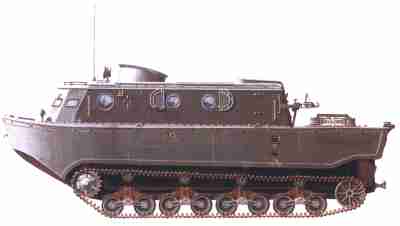| In 1936, Rheinmetall Borsig
AG was approached by the German army general staff to build a special
amphibious tracked vehicle for landing operations. The tractor would be
able to two behind it a floating trailer capable of accommodating vehicles
or other cargo weighing up to 18,000kg. On water the tractor would
function as a tug for the floating cargo trailer. After landing the
tractor would still have to move the trailer to a safe place to unload the
cargo.
Rheinmetall tackled the project and the
product became known as the Land-Wasser-Schlepper (land-water tractor) or
LWS. The LWS was actually and simply a motor tug built with tracks. It was
a large and strange machine that nonetheless turned out to be a rugged
vehicle (or boat?). There were two long sets of tracks, one on the flat
bottom on each side of the LWS. There were four pairs of road wheels
suspended from leaf-spring suspensions on each side. The boat part of the
LWS had a clean, pronounced bow, and on top there was a compartment for
the crew of three and extra room for another 20. The funnel-like structure
on top of the cabin was actually the engine's air intake. Two large
propellers were installed at the rear, or stern, for propulsion in water.
To make the LWS more boat-like there were portholes on both sides of the
crew cabin.
On land the floating trailer looked like
a large slab-sided vehicle, and was supported by wheels on one forward
axle and two rear ones. On the back side a ramp could be opened for
unloading. A typical load was an SdKfz 9 18-tonne halftrack, and the crew
would be housed in the LWS for the aqueous leg of the journey.
The LWS and trailer idea was tried and
tested quite slowly and leisurely until "Seelöwe" (Operation
Sea Lion, the invasion of Great Britain) was to become reality after the
fall of France. The LWS and trailer could certainly be used in such an
amphibious operation, but they were more suited for calmer waters of
inland water bodies, not the tempestuous English Channel. The LWS program
was for a while carried out with more urgency, but was never materialized.
By 1941 the project was dropped, when the prospect of Seelöwe was
overshadowed by the much more serious Operation Barbarossa (invasion of
Russia).
One disadvantage of the LWS was the lack
of armour, and armour was deemed necessary for any amphibious operations.
The floating trailer was also thought to be too cumbersome and clumsy so a
new scheme was devised. The overall structure of the LWS was kept, but the
new vehicle had the track work and suspension of the ubiquitous PzKpfw IV
to support a lightly armoured superstructure.
Two new vehicles, called
Panzerfähre or PzF, were built and designed to take a large pontoon
between them to transport a tank or other cargo. Thus the PzF would act as
a ferry rather than a tractor. However, the program was cancelled in 1942
after the two prototypes were built and tried. A pre-production of seven
LWS's were built and they served on the Eastern front. After the war the
LWS was taken by the British to England for technical assessment.
http://www.geocities.com/pentagon/2833/heer/amphibious/lws/lws.html |
